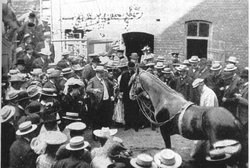Clever Hans
|
|
Clever Hans (in German, der Kluge Hans) was a horse that was apparently trained to perform arithmetic and other intellectual tasks. Philosopher and psychologist Carl Stumpf formed a panel of 13 prominent scientists, known as the Hans Commission, to study the claims that a Clever Hans could count. The commission then passed off the evaluation to psychologist Oskar Pfungst. Pfungst demonstrated that in fact the results were due to an artifact, and the horse was responding to the body language of its trainer; his results were published in 1907. This kind of artifact is a recurrent danger in studies of animal cognition, and in honour of Pfungst's study, it has been known ever since as a Clever Hans effect.
| Contents |
Clever Hans and Pfungst's study
The horse, Hans, had been trained by a Mr. Van Osten to tap out the answers to arithmetic questions with its hoof. The answers to questions involving reading, spelling and musical tones were converted to numbers, and the horse also tapped out these numbers. Pfungst tested the basis for these abilities by:
- isolating horse and questioner from spectators, so no cues could come from them
- using questioners other than the horse's master
- by means of blinkers, varying whether or not the horse could see the questioner
- varying whether or not the questioner knew the answer to the question in advance.
Using a substantial number of trials, Pfungst found that the horse could get the correct answer even if Van Osten himself did not ask the questions, ruling out the possibility of fraud. However, the horse got the right answer only when the questioner knew what the answer was, and the horse could see the questioner. He then proceeded to examine the behaviour of the questioner in detail, and showed that as the horse's taps approached the right answer, the questioner's posture and facial expression changed in ways that were consistent with an increase in tension, which was released when the horse made the final, "correct" tap. This provided a cue that the horse could use to tell it to stop tapping.
The social communication systems of horses probably depend on the detection of small postural changes, and this may be why Hans so easily picked up on the cues given by Van Osten (who seems to have been entirely unaware that he was providing such cues). However, the capacity to detect such cues is not confined to horses. Pfungst proceeded to test the hypothesis that such cues would be discernible, by carrying out laboratory tests in which he played the part of the horse, and human participants set him questions to which he gave numerical answers by tapping. He found that 90% of participants gave sufficient cues for him to get a correct answer.
Clever Hans effect
The risk of Clever Hans effects is one strong reason why comparative psychologists normally test animals in isolated apparatus, without interaction with them. However this creates problems of its own, because many of the most interesting phenomena in animal cognition are only likely to be demonstrated in a social context, and in order to train and demonstrate them, it is necessary to build up a social relationship between trainer and animal. This point of view has been strongly argued by Irene Pepperberg in relation to her studies of parrots, and by Alan and Beatrice Gardner in their study of the chimpanzee Washoe. If the results of such studies are to gain universal acceptance, it is necessary to find some way of testing the animals' achievements which eliminates the risk of Clever Hans effects. However, simply removing the trainer from the scene is not an appropriate strategy, because where the social relationship between trainer and subject is strong, the removal of the trainer is likely to produce emotional responses and prevent the subject performing at all. It is therefore necessary to devise procedures where none of those present knows what the animal's correct response should be.
For an example of an experimental protocol designed to overcome the Clever Hans effect, see Rico (Border Collie).
As Pfungst's final experiment makes clear, Clever Hans effects are quite as likely to occur in experiments with humans as in experiments with other animals. For this reason, care is often taken in fields such as perception, cognitive psychology, and social psychology to make experiments double-blind, meaning that neither the experimenter nor the subject knows what condition the subject is in, and thus what his or her responses are predicted to be. Another way in which Clever Hans effects are avoided is by replacing the experimenter with a computer, which can deliver standardized instructions and record responses without giving any cues.
External link
- Classics in Psychology: Oskar Pfungst's Clever Hans (The Horse of Mr. von Osten), by Robert H. Wozniak (http://www.thoemmes.com/psych/pfungst.htm)
Reference
Pfungst, O. (1911). Clever Hans (The horse of Mr. Von Osten): A contribution to experimental animal and human psychology (Trans. C. L. Rahn). New York: Henry Holt. (Originally published in German, 1907).
The indecisive German World War II Field Marshal Hans Günther von Kluge was, not surprisingly, known by the nickname "der Kluge Hans" (clever Hans).de:Kluger Hans he:הנס החכם pt:Hans esperto

